Content marketing isn’t about empty buzzwords or chasing fads. In today’s climate, successful marketers ground their strategies in hard data and measurable results. 2024 is a year where understanding consumer trends, platform shifts, and the expanding role of technology isn’t a bonus – it’s a necessity.
Let’s explore the content marketing landscape, identifying the major trends backed by solid research, so you can refine your strategy and stay ahead of the curve.
Trend #1: AI as an Empowering, Not Replacing, Force
The rise of AI-powered tools like ChatGPT has sent both shivers and thrills through the marketing world. Here’s what the data tells us:
- AI is widespread: 73% of marketing professionals already use some form of AI in their work, according to Salesforce Marketing Automation Trends Report, 2023.
- Around 67% of marketers indicate that their company’s data infrastructure is insufficiently prepared for generative AI implementation.
- Simultaneously, 63% emphasize the critical role of trusted customer data in ensuring the successful utilization of generative AI in the workplace.
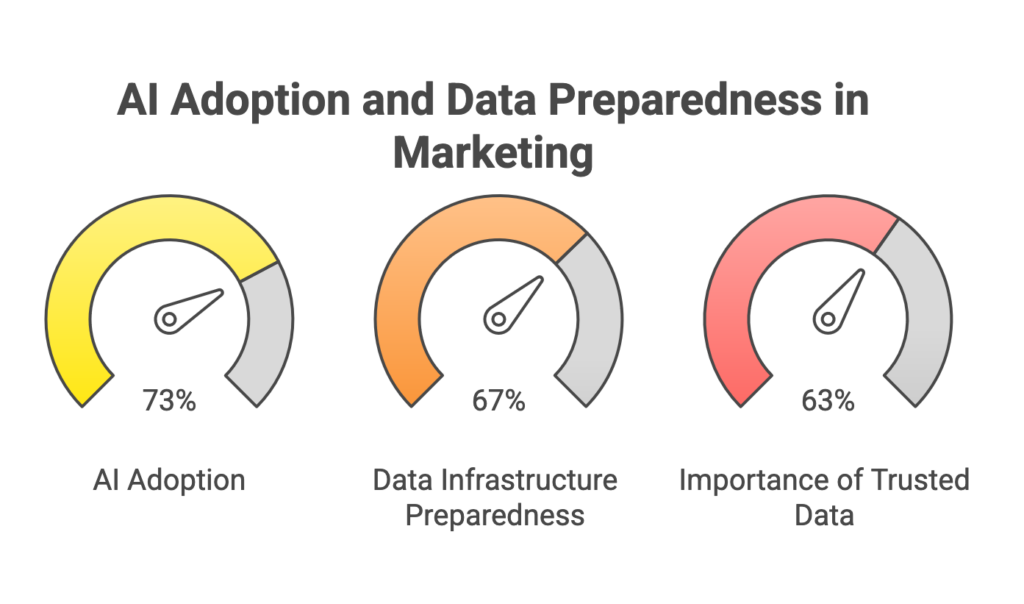
Not a human replacement: Fears of AI-written content “taking over” are overblown. Instead, successful marketers will learn to harness AI as a tool for tasks like idea generation, outlining, or editing to streamline processes.
Google’s Stance: Search engines prioritize quality over the method of creation or the Content Management System (CMS) you use. Is it better to use a tool like WordPress or make your own special website when you want lots of people to find it easily on the internet? As Google’s John Mueller states , “Not for SEO, but you can focus more on the content if you don’t spend all your time creating a new CMS for yourself.”
Semrush released an interesting 2024 report that had AI as its main focus. Here are some interesting statistics that every business owner and marketer needs to know.
- 67% of small businesses already use AI for content and SEO
- 68% of businesses report increased content marketing ROI with AI
- 65% of companies achieve better SEO results thanks to AI
- 49% of AI users craft complex, multi-step AI prompts
- 44% of small businesses rely on AI at least moderately
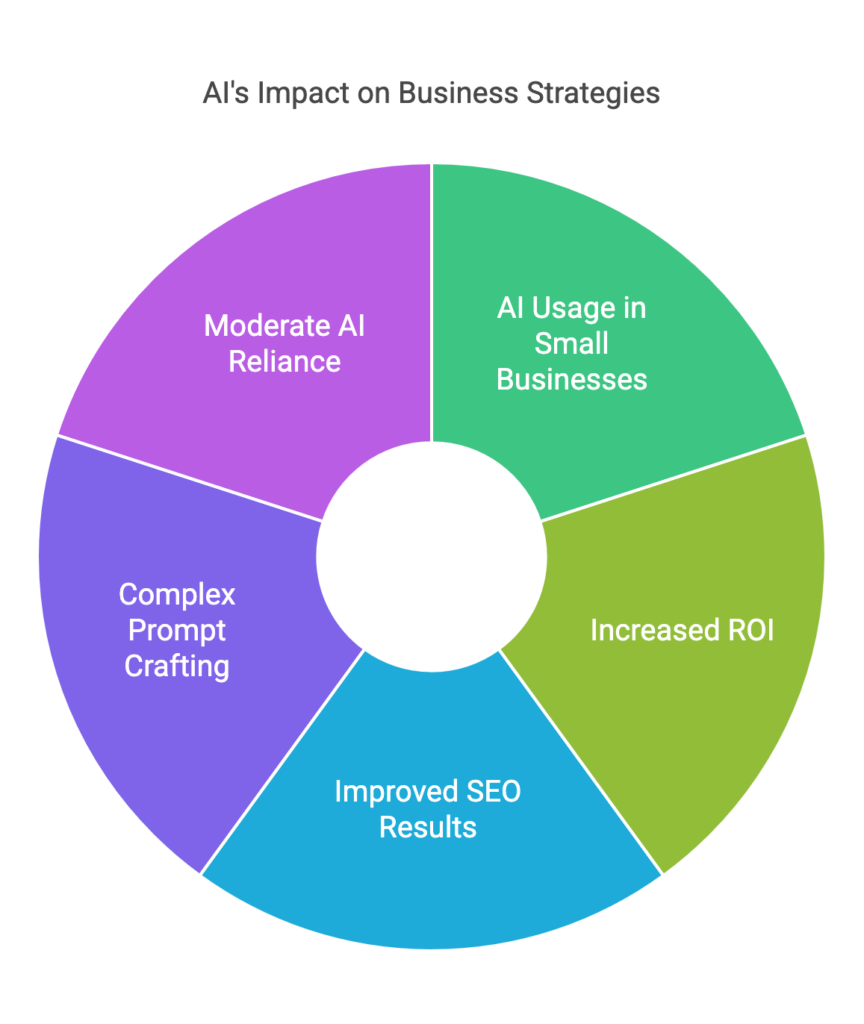
Additional Observations & Trends from the Report:
Businesses primarily use AI for:
Blog post outlining, topic ideation, and headlines
Keyword research and SEO audits
Social media & ad copy, image generation
Benefits of AI include:
Streamlined content creation
Enhanced content engagement
More impactful decision-making
AI Adoption:
- 31% of small businesses plan to adopt AI for content marketing within the next year.
- 26% of businesses that already use AI plan to increase their AI usage for content marketing within the next year.
Types of AI Tools:
- 24% of small businesses use AI tools to conduct keyword research to develop blog posts.
- 20% of businesses leverage AI for image creation and generation.
Challenges with AI:
- 38% of small businesses identify the cost of AI tools as a barrier to adoption.
- 24% struggle with understanding how to leverage AI tools effectively.
Trend #2: It’s the Era of Audience Understanding
Knowing your audience isn’t a new idea, yet 2024 demands a data-centric approach:
Go beyond demographics: While age and location matter, they’re just the start. Use customer surveys, website analytics, and social listening to understand deeper psychographics: values, pain points, and preferred content formats.
First-party data is king: With growing privacy concerns, leveraging the data you gather directly (with consent) is crucial. Analyze past content performance and CRM data to tailor messaging.
- Personalization at scale: 72% of consumers say they only engage with marketing messages tailored to their interests, according to a study by SmarterHQ.
- The same survey also states that 51% of consumers prefer email as the best way for a brand to communicate, while social media comes second with 25% of people favoring it.
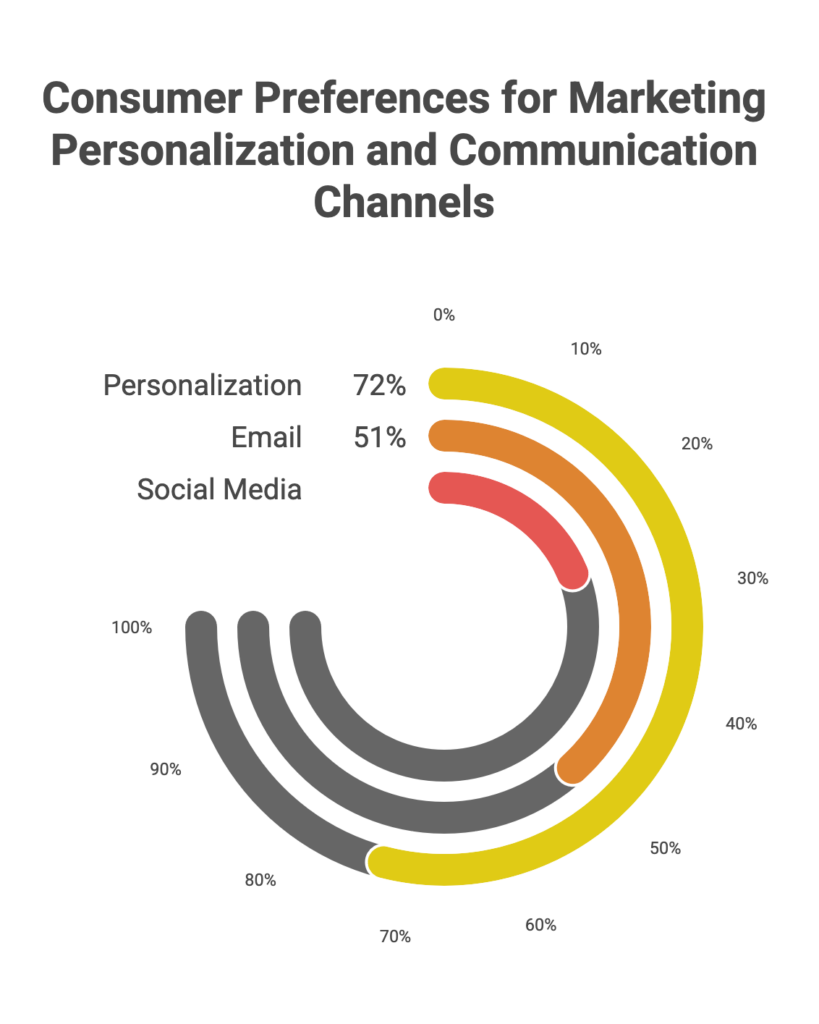
- In the same survey, Amazon stands out as the most trusted brand among consumers, with 48% trusting it to handle their data responsibly. This trust surpasses that of banks, Apple, Google, and other major brands. Millennials and Generation Z show particular trust in Amazon, rating it 2.1 times higher than their trust in banks. In contrast, social media companies rank lowest in consumer trust, likely influenced by recent headlines and concerns about account hacking.
To sum up the survey, here are the main stats:
- 72% of consumers now only engage with marketing messages tailored to their interests.
- 86% of consumers say they are concerned about their data privacy.
- 90% of consumers are willing to share behavioral data for a cheaper and easier shopping experience.
- 74% of consumers rank push notifications as creepier than other channels.
- 63% of consumers will stop buying from brands who use poor personalization tactics.
- 51% of consumers say they are more likely to trust a brand that personalizes their shopping experience.
- 46% of consumers say they are comfortable with brands using their purchase history to personalize their experience.
- 44% of consumers say they are comfortable with brands using their browsing behavior to personalize their experience.
- 42% of consumers say they are comfortable with brands using their location to personalize their experience.
- 38% of consumers say they are comfortable with brands using their demographics to personalize their experience.
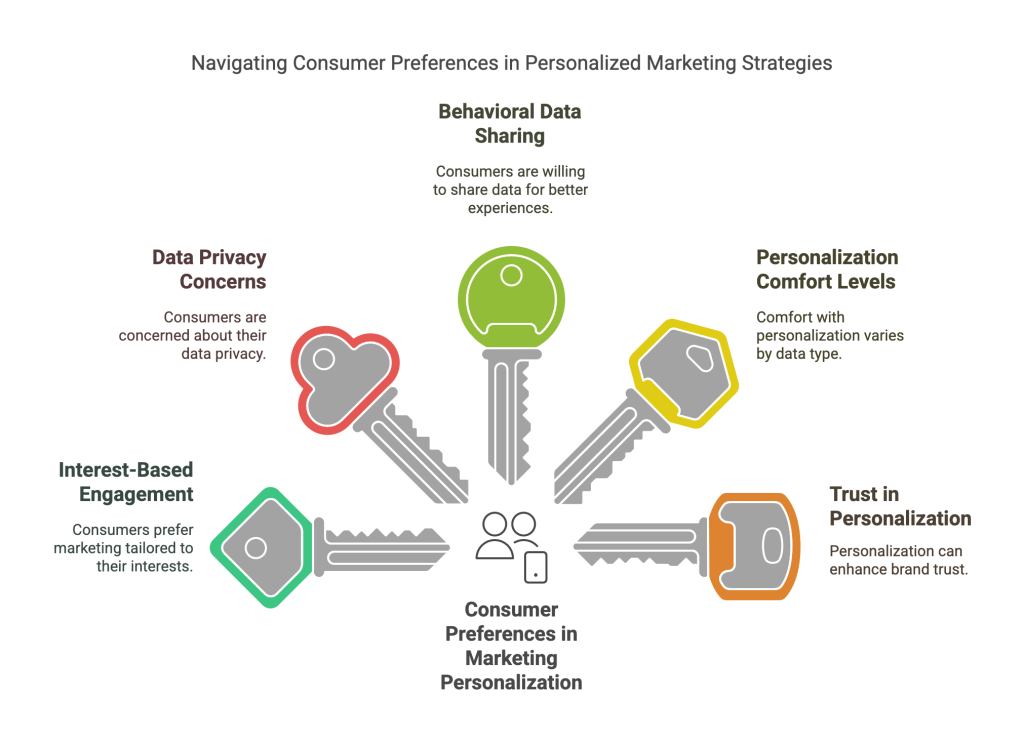
Trend #3: Video Domination – But With a Twist
Video isn’t going away, but the form will continue to evolve:
Short-form reigns supreme: TikTok’s success isn’t a fluke. Platforms like Instagram Reels and YouTube Shorts drive views and engagement. The average attention span is short – adapt your videos accordingly.
Don’t neglect SEO: Optimize your titles, descriptions, and tags for discoverability, as even short-form video is indexed by search engines.
Live streaming’s authentic appeal: Going live offers unfiltered, real-time connection. A study by Livestream and New York Magazine found 82% of audiences prefer live video from a brand over social posts. Here are more stats from this survey:
- 82% of consumers prefer live video from a brand to social posts.
- 81% of viewers watched more live video in 2016 than in 2015.
- 87% would prefer to watch video online if it meant more behind-the-scenes content.
- 67% of audiences who watched a livestream purchased a ticket to a similar event.
- 80% would rather watch live video from a brand than read a blog.
- 67% say quality is the most important factor when watching a livestream.
- 56% of most-watched live content is breaking news, with conferences and concerts tied in second place with 43%.
- 45% of audiences would pay for live video from a favorite team, speaker, or performer.
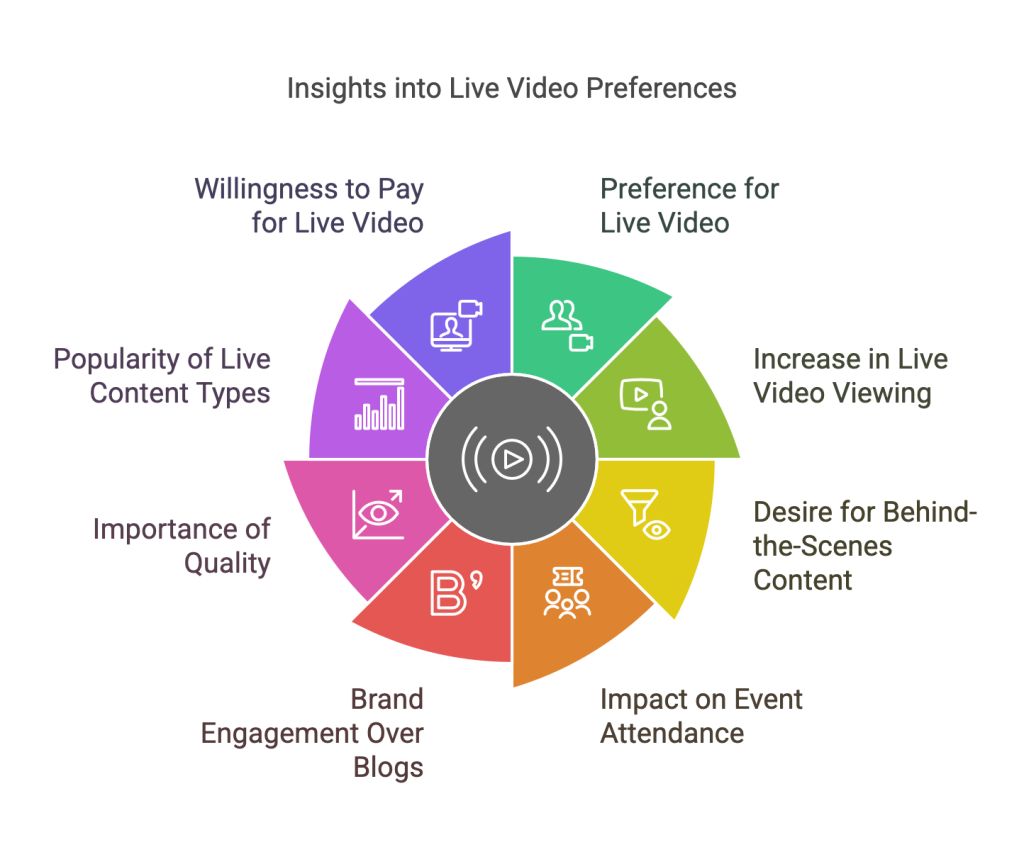
Trend #4: Thought Leadership = Trust Building
Consumers are bombarded with content. Differentiate yourself by proving expertise:
Solve genuine problems: Go beyond self-promotion. Create in-depth guides, tutorials, and analysis offering real value to your audience.
Establish authoritative voices: Feature subject matter experts within your company as contributors, showcasing their insights on industry trends.
Embrace diverse perspectives: Representation matters. Include voices from various backgrounds to reflect your audience and enhance credibility.
Trend #5: Interactive Content: Engagement that Counts
Passively consumed content is less memorable. These interactions stick in the mind:
Quizzes and polls: Entertaining, while gathering valuable data. Embed within articles or use platform-specific features like Instagram Stories polls.
Contests and challenges: Leverage user-generated content (UGC) by encouraging submissions and participation, enhancing your community.
Interactive infographics or tools: Let the audience input information and get personalized results (e.g., a marketing budget breakdown calculator).
Additional Data-Backed Trends to Watch:
Evolving social platforms: Be ready to pivot as established platforms adjust algorithms and new spaces emerge.
Content designed for voice search: Optimize for natural language question phrases.
Ethical marketing in an AI world: Maintain transparency about AI utilization.
Influencer marketing’s shift: Smaller niche influencers offer dedicated communities.
Focus on retention not just acquisition: Engage current customers through newsletters, gated content, and loyalty programs.
Repurposing existing content: Get more mileage by turning high-performing assets into multiple formats.
Audio content: Podcasting remains popular, consider short-form audio snippets.
Employee advocacy: Empower your team to be brand ambassadors on social media.
‘Snackable’ content: Easily digestible bites for on-the-go consumption.
AR/VR potential: Still developing, but consider how the Metaverse might factor in.
Proving ROI to stakeholders: This never goes out of style! Track relevant metrics.
Putting Data to Work: Actionable Steps
Audit your analytics: What does your existing audience data tell you?
Survey your customers: Ask directly what problems they need solved.
Experiment with new formats: Test-drive short-form video or quizzes.
Invest in personalization tools: Even basic email segmentation goes a long way.
Be adaptable: The digital landscape shifts rapidly.
Content Marketing statistics to note
- According to Brightedge, at the beginning of 2023, a survey conducted among SEO professionals revealed that 90% of them considered SEO to be a crucial focus for their organizations in the upcoming year. Their study findings? SEO in 2024 is all about making websites faster, using keywords smarter, and showing that the content is relevant. This helps websites rank higher in search results. For businesses, it’s important to focus on these things to do well in SEO.
Ahrefs compiled statistics on content marketing that should be highly beneficial as well.
SEO
- 96.55% of pages get no organic search traffic from Google. (Ahrefs)
- 68% of online experiences begin with a search engine. (Brightedge)
- 71% of B2B researchers start their research with a generic search instead of branded search. (Google)
- 5.7% of pages will rank in the top 10 search results within a year of publication. (Ahrefs)
- The more backlinks a page has, the more organic traffic it gets from Google. (Ahrefs)
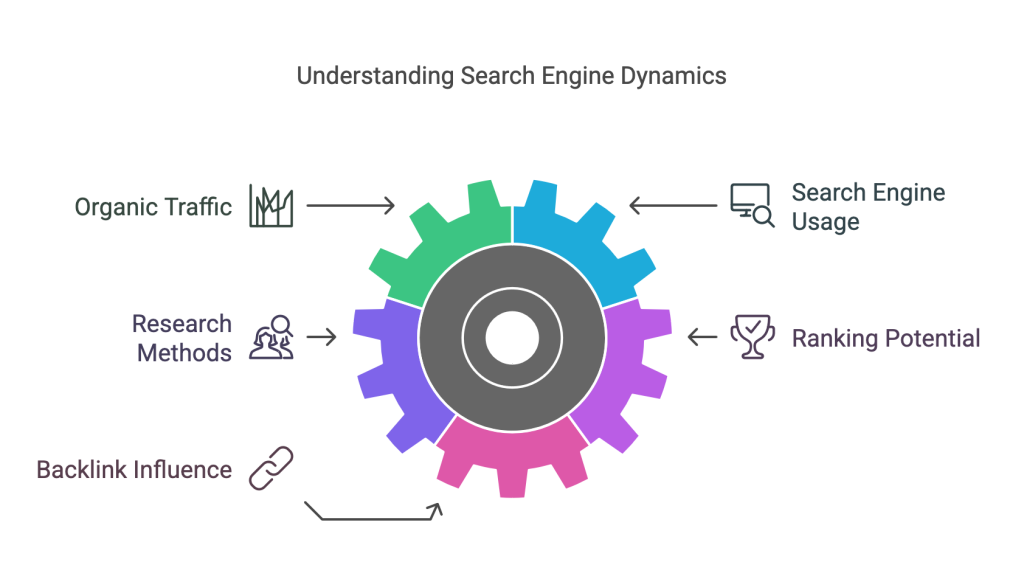
Blogging
- 85.19% of all blog traffic comes from organic search. (Animalz)
- 70% of people would rather get information from blogs than traditional advertisements. (Demand Metric)
- There are more than 600 million blogs out of 1.9 billion websites in the world. (Web Tribunal)
Video Marketing
- Video is the most popular type of content created by marketers. (Hubspot)
- 70% of viewers bought a product after seeing it on YouTube. (Google)
- 91% of businesses use video as a marketing tool. (Wyzowl)
- 96% of people have watched an explainer video to learn more about a product or service. (Wyzowl)
Podcasting
- 64% of Americans listened to a podcast as of 2023. (Edison Research)
- 80% of podcast listeners listen to all or most of each episode. (Podcast Insights)
Email Marketing
- Lots of marketers use email to share content, about 73% of them in 2023.
- Short subject lines with 61-70 characters work well.
- People usually spend around 51 seconds reading newsletters, and only about 19% get fully read. Generative AI helps make emails, and many find it effective. Marketers often check email engagement to see how well their content is doing. Adding videos to emails can boost open and click-through rates. Also, many marketers personalize emails with subject lines and dynamic content.
Sales Funnel (Indirectly Related)
- Content marketing generates over 3x as many leads as outbound marketing and costs 62% less. (Demand Metric)
- 44% of buyers say they typically consume three to five pieces of content before engaging with a vendor. (DemandGen)
The future of content marketing
- Content marketing continues to be a powerful tool for businesses, with 70% of marketers actively investing in it (HubSpot, State of Marketing Report, 2024).
- The good news is that AI-powered personalization in marketing has the potential to boost ROI by up to 70%.
Source: Kibocommerce
The world of content marketers
- According to a 2023 study by the Content Marketing Institute, the biggest obstacle to content creation is the shortage of resources (58% of respondents).
- Other challenges include synchronizing content with the buyer’s journey (48%), coordinating content efforts between sales and marketing (45%), dealing with workflow and content approval processes (41%), accessing subject matter experts (38%), staying updated on new technologies (34%), absence of a clear strategy (25%), staying informed about privacy rules, regulations, and compliance (19%), and integrating different technologies (15%).
Some more stats from CMI are as follows:
- Short articles/posts are the go-to for 94% of B2B marketers, with videos following closely at 84%, and case studies/customer stories at 78%. Interestingly, 53% of marketers find case studies/customer stories and videos to be highly effective.
- When it comes to content distribution, 90% of B2B marketers utilize organic social media platforms, 79% leverage blogs, and 73% send out content through email newsletters. Surprisingly, in-person events and webinars, used by 56%, yield the best results according to marketers.
- LinkedIn is the preferred social media platform for 84% of B2B marketers, offering the best value among the platforms they use.
- Regarding platform usage changes, 32% of B2B marketers decreased their X use last year. On Facebook, 20% decreased, 22% increased, 38% stayed the same, and 20% didn’t use it. For Instagram, 10% decreased, 32% increased, 28% stayed the same, and 31% didn’t use it. On YouTube, 9% decreased, 32% increased, 39% stayed the same, and 20% didn’t use it. On LinkedIn, 72% increased, 24% stayed the same, 2% decreased, and 2% don’t use it. Notably, 81% of B2B marketers aren’t on TikTok, while 10% increased their use, 7% decreased, and 10% maintained their use.
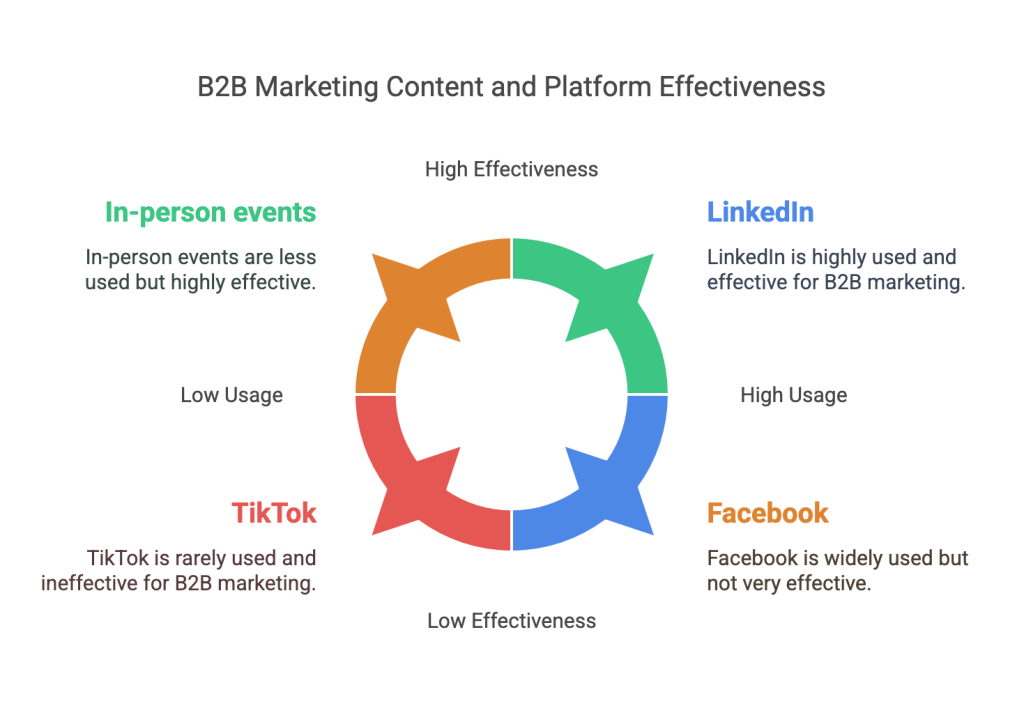
- Among B2B marketers, 28% deem their content marketing efforts extremely or very successful.
- The key contributors to their success include a deep understanding of their audience (79%), alignment of content with organizational objectives (68%), effective measurement and demonstration of content performance (61%), thought leadership (60%), collaboration with other teams (55%), and a documented strategy (53%).
Key Trends in Video Marketing
Wyzowl has some interesting statistics that deserve the attention of SMBs, content marketers, and digital marketing agencies.
- Widespread Adoption: Over 90% of businesses now use video marketing, highlighting its status as a nearly essential digital marketing tool.
- Strategic Importance: 88% of marketers view video as vital to their overall strategy.
- Challenges and Growth: While time constraints remain the top barrier for non-users, 68% of those who don’t use video plan to start in 2024.
- Diverse Content Creation: Live-action videos are most common, but animated and screen-recorded formats are popular. Outsourcing content creation is growing; 38% use a mix of in-house and external teams.
- AI’s Emergence: 75% of marketers have used AI tools for video creation and editing, suggesting rapid adoption of these technologies.
- Strong ROI: 90% of marketers see a good ROI from video. Short-form content (30-60 seconds) performs best across a range of goals (brand awareness, lead generation, sales).
- Consumer Demand: Consumers overwhelmingly want more video content from brands. High-quality videos are key, with 87% of consumers saying it impacts their trust.
YouTube’s overarching influence on viewers
YouTube demonstrates immense reach and influence within the media landscape. Its viewership surpasses all cable TV networks combined among the crucial 18-49 age demographic. This, along with the surge in specific content areas – such as study skills, “van life”, recipe tutorials, gaming, and home improvement – emphasizes the platform’s power in shaping trends and interests. The data showcases how YouTube has evolved into a primary resource for viewers seeking entertainment, education, and inspiration, making it a vital platform for businesses and individuals to tap into.
- YouTube’s weekly reach among 18-49-year-olds exceeds that of all cable TV networks combined.
- Watch time of “study skills” videos on YouTube grew by over 300% year-over-year.
- Channels focused on “van life” themes number over 1,200 on YouTube.
- Recipe-related video watch time on the platform increased by 250% in the past two years.
- Watch time for home renovation content on YouTube has surged by over 200% in the last year.
Who dominates search? And by how much?
Google utterly dominates the global search engine market with a 91.37% share. Other notable players include Bing, YANDEX, Yahoo!, and Baidu, but their market shares are dramatically smaller.
- Google: 91.37% market share
- Bing: 3.37% market share
- YANDEX: 1.64% market share
- Yahoo!: 1.1% market share
- Baidu: 0.99% market share
- DuckDuckGo: 0.53% market share
Blogging rules in more ways than one
Marketers who adopt consistent blogging tactics have a 13x greater chance of achieving strong ROI, according to HubSpot. Blogging remains a powerful content marketing tool, driving website traffic, leads, and brand awareness. Companies that blog consistently enjoy significant benefits, but longer posts and visual content are key to maximizing results.
5 Key Stats:
- Companies with active blogs generate 67% more leads than those without. (DemandMetric)
- 80% of internet users engage with both blogs and social media. (DemandMetric)
- The average blog post length is 1,376 words. (Orbit Media)
- Bloggers spend an average of 4 hours and 10 minutes writing a typical blog post. (Orbit Media)
- 40% of marketers say original visuals perform best in articles. (Venngage)
Social media fire power: Who rules
Social media usage continues to expand globally, with platforms boasting billions of monthly active users. Facebook remains the undisputed leader, while WhatsApp and TikTok demonstrate impressive reach. Chinese networks like WeChat and Douyin also hold significant sway, reflecting the influence of local content and context in the social media landscape.
- With 3.05 billion monthly active users, Facebook holds the title of the most popular social network worldwide.
- Massive Reach: Global social media usage reached an estimated 3.96 billion users in 2022, demonstrating its far-reaching impact.
- WhatsApp’s Widespread Use: WhatsApp boasts an impressive 2 billion monthly active users.
- TikTok’s Meteoric Rise: TikTok’s international success brings its total monthly active users to 1.56 billion.
- China’s Influence: Chinese social networks WeChat, QQ, and Douyin all command significant audiences within their respective regions.
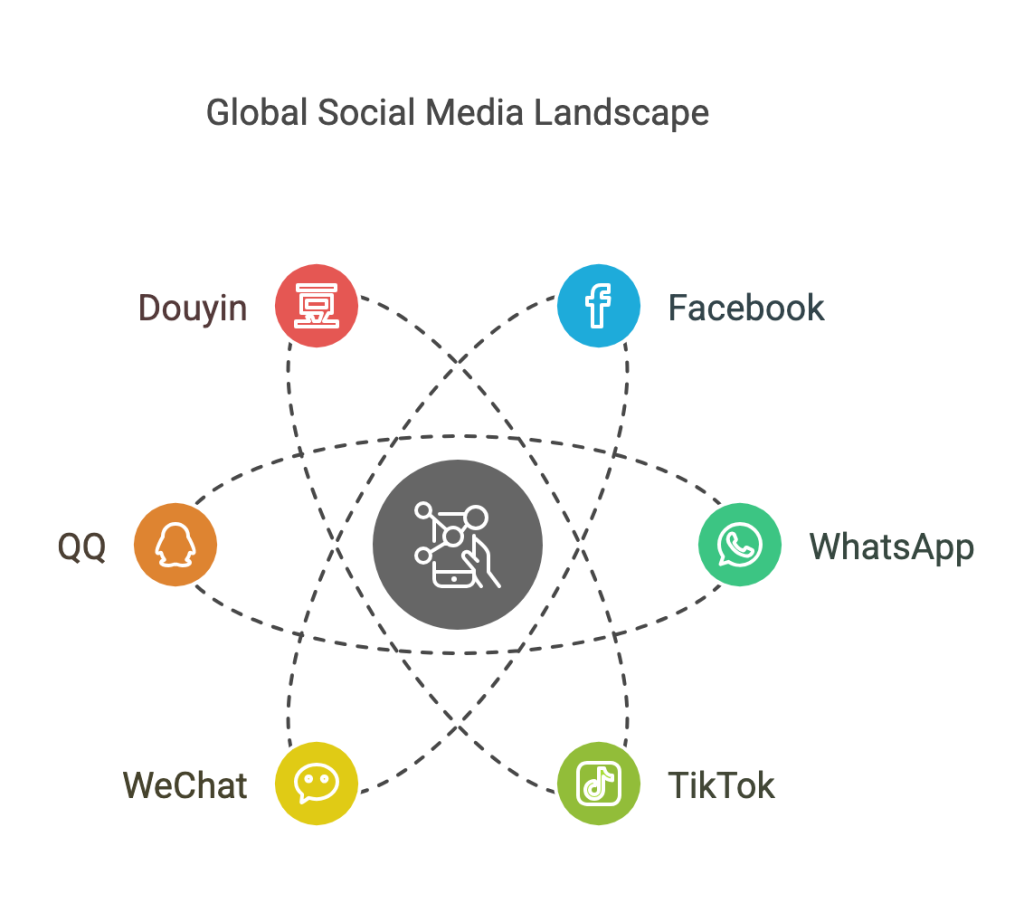
The Middle Eastern countries Bahrain, Kuwait, Qatar, and Saudi Arabia have the highest social media adoption rates according to the latest ranking. South Korea follows closely behind as the first non-Gulf country on the list.
Here are 9 bullet points summarizing the key findings:
- Bahrain, Kuwait, Qatar, and Saudi Arabia have the highest social media adoption rates.
- South Korea is the first non-Gulf country with high social media adoption.
- North Korea has the lowest social media adoption rate due to government restrictions.
- Eritrea and Turkmenistan also have low social media adoption rates due to government limitations.
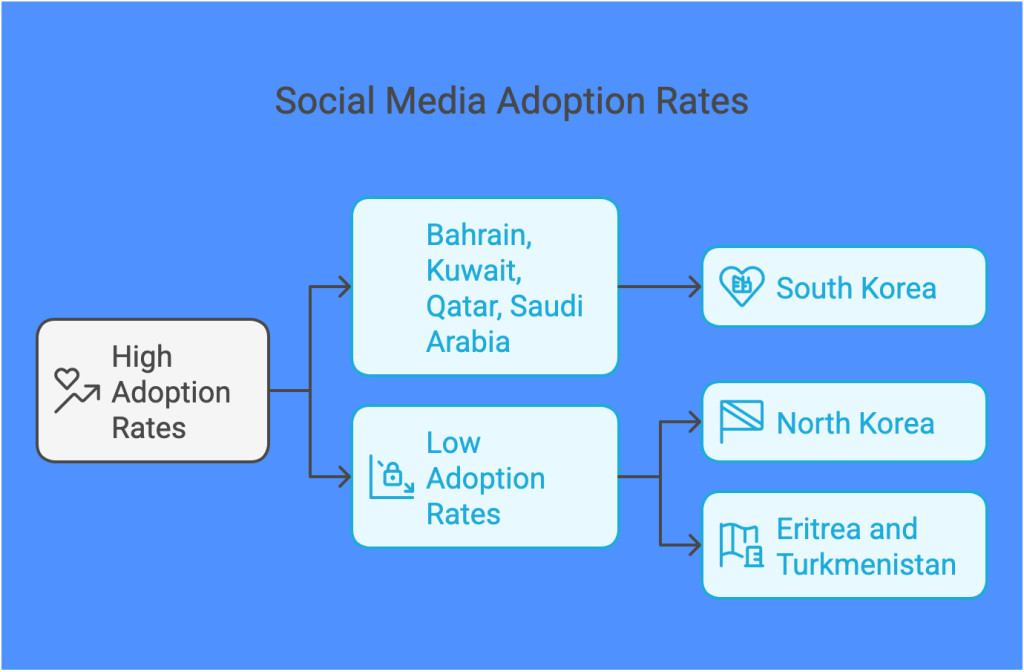
Internet penetration
- India has the highest number of “unconnected” individuals, with over 680 million.
- Internet penetration exceeds 25% across all global regions.
- Central Africa remains the region with the lowest internet adoption rate (under 50%).
- North Korea has the world’s lowest internet adoption due to government-imposed restrictions.
- Typical internet users spend an average of 6 hours and 40 minutes online daily.
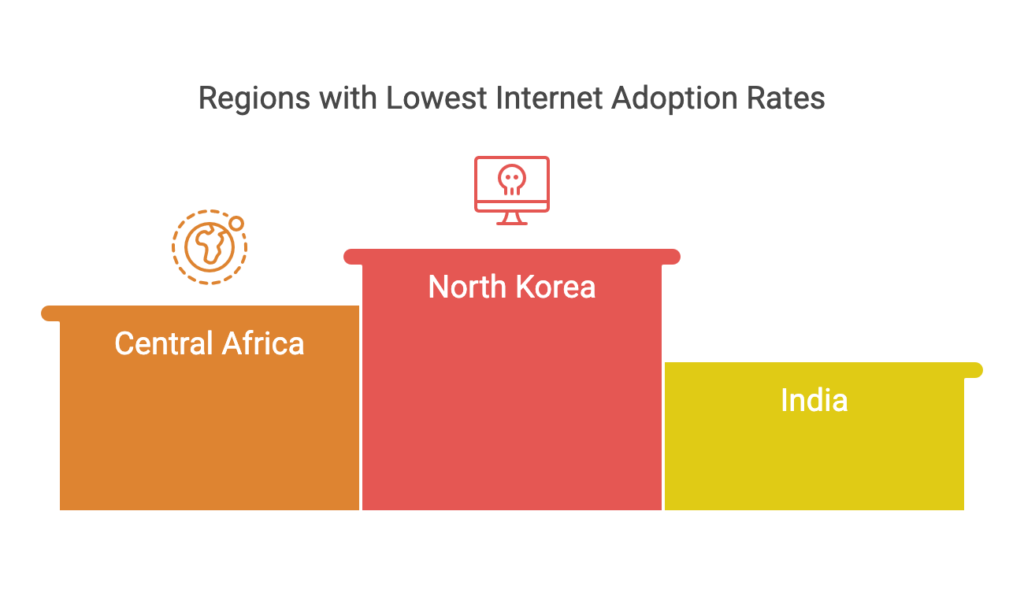
Conclusion
Numbers by themselves usually don’t convince people, but they can make your stories stronger. Use these stats and other helpful information to support your reasons for getting the resources you need, outline a successful content strategy, and figure out how important content will be in your plans for 2025 and beyond.
